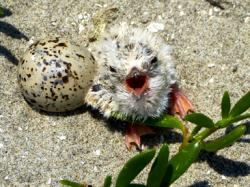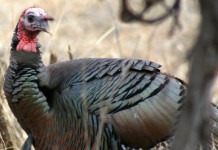Beachgoers along the Gulf Coast, including along Texas’ Padre Island National Seashore and its bays and estuaries, are urged to be mindful of the many beach-nesting birds that will be tending to young birds and perhaps a few remaining eggs this time of year.
“People visiting the beaches are often unaware of the many species of birds that nest in the sands near where they are swimming, fishing and recreating. As a result, nests can accidentally get trampled, destroyed, or abandoned,” said the American Bird Conservancy‘s Kacy Ray, Gulf Beach-Nesting Bird Conservation Project Officer, in a news release.
“The best thing for beachgoers to do is to avoid getting close to areas where larger congregations of birds are gathered, and to always respect areas that are roped off or marked with signs designating an area that is used by nesting birds,” Ray added. “The habitat for these birds is diminishing every year due to beach development, erosion, and ever-increasing recreational use, so the birds can really use any break we can give them. They have no other place to go.”
Ray points out that it can be difficult for the year-round resident and the casual vacationer to see the difference between a bird that is simply sitting on the sand and one tending eggs or a nest or young.
You know you’ve entered a nesting area when large groups or individual birds vocalize loudly, dive-bomb your head, or feign injury to lead you away from their nests. If this happens, back away and share the beach so the birds can successfully rear their young.
Ray said that there are special concerns for different regions of the country.
Along the Gulf Coast, you will find least terns and black skimmers, which nest in colonies. Wilson’s and snowy plovers and American oystercatchers can also be found, but tend to be spread out in more isolated single-pair territories along the coast, according to the release.
The conservancy is leading a Gulf Coast conservation effort that is working to identify and implement protective measures for vulnerable beach-nesting birds. The project utilizes expertise not only from the conservancy, but from partners throughout the Gulf region, including Houston Audubon.
Funded by the National Fish and Wildlife Foundation, the project focuses on protecting and monitoring beach-nesting bird habitat in Texas, Louisiana and Florida. It also includes statewide public awareness campaigns in Texas and Louisiana asking boaters, anglers and other recreationists to “Fish, Swim, and Play from 50 Yards Away” from birds nesting on islands and beaches. Regional partners include the Coastal Bend Bays & Estuaries Program.






















